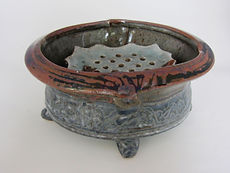In Love with the Toroid
July 1, 2018
Ever since I first figured out how to make the hollow ring form on the potter’s wheel, I have been fascinated with this form. I love that people are amazed that one can make such a shape on the wheel. The hollow ring form is properly called a toroid.

This is a mathematical term describing a three-dimensional shape created by rotating a geometric shape in a plane perpendicular to the axis of rotation. The diagram to the right illustrates this better than a written explanation. A special case of a circle rotated is called a torus, or more commonly, a donut.
The toroid form in clay is not anything new. In fact, it probably goes back several thousand years. A piece in the British Museum, made in Italy, is dated to 340 B.C.E. Other examples of this form have been found in work from 6th century Japan, from ancient China, and from 9th century Spain.
The image at the right shows a toroid bottle found in Salem, North Carolina, from the period 1793-1800.
One of the most creative applications of this form comes from Ray Bub (http://www.raybub.com). He cuts the toroids apart and reassembles them into highly unique teapots. Ceramic Arts Daily did a nice article on Ray’s technique (March 9, 2009).
March 25, 2018


The creative challenge for me is to design new functional objects that incorporate the toroid. You can see many of my attempts in the Gallery and Archive sections of my website.
Soda Firing Workshop

Bill with one of his signature pieces.
On March 10 – 13, I had the privilege of attending a soda firing workshop with Bill Wilkey, an amazing young potter from Helena, Montana. The workshop was held at the studio of David and Mary Cuzick in Spring Valley, California. Bill Wilkey was featured as one of Ceramics Monthly magazine’s Emerging Artists in 2014. He was also a resident fellow at the Archie Bray Foundation in Helena.
The first day, Bill introduced us to the flashing slips and glazes we would be using on the bisqueware we brought to the workshop. The rest of the day we glazed our pots, added wadding, and loaded the kiln (in the rain!). While the kiln was
The final day was the exciting opening of the kiln, and review and discussion of the results. Bill also finished some of the pieces he had in process. This was my first exposure to soda firing. It was a lot of fun, especially working with a small and friendly group. One



firing the next day, Bill demonstrated his throwing and altering techniques, creating divided and textured surfaces on a variety of forms that represent his distinctive style. On the third day, Bill continued his demonstrations and shared more of his techniques.
Kiln in heavy reduction!
Opening the kiln.
of my pieces from the workshop is shown at the left. This and others shown in the Gallery are noted as soda fired. Thanks to Merle Lambeth for some of the photos.
Vase of mine from the workshop.
July 31, 2017
John Glick Appreciation
I first encountered the pottery of John Parker Glick when he was an undergraduate student at Wayne State University in Detroit. His pottery, shown at the annual student exhibition, really resonated with me. I later saw his work when he was a graduate student at Cranbrook Academy of Art. I was a regular visitor to Cranbrook’s annual student show, where John’s work was shown. I finally met him sometime in the mid-60s during the Ann Arbor Art Fair when I was a graduate student at Michigan. I was able to acquire a few of his pots that I have used and enjoyed in my home for the past 50 years.

Glick Soap Dish in use since ~1965.
Last summer I had the opportunity to visit Cranbrook where John Glick's pottery was on exhibit. This was a retrospective exhibition spanning John's more than 50 years as a studio potter. The work on display represented some of his best pieces from his own collection. He had the habit of setting aside his best works to preserve his legacy for a future retrospective project. The work on exhibition at Cranbrook was selected from the more than 1000 pieces in his collection. All the pieces in the exhibit are documented in a wonderful catalog, John Glick: A Legacy in Clay, published by Cranbrook.
I absolutely love John's work, especially his functional wares. I love the forms, the colors he achieves with his slips and glazes, and the fact that much of his work is totally functional. I have been told that his pots are lovingly used and passed down through generations. That is definitely true in my case; I am sure my children will treasure them as I have. John has been my "pottery hero" for many years and inspired my own work. Sadly, John passed away on April 6, 2017. He will be greatly missed.